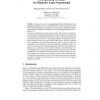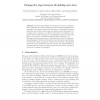413 search results - page 22 / 83 » On the Relation Between ID-Logic and Answer Set Programming |
AICOM
2006
13 years 9 months ago
2006
In this work we present a backjumping technique for Disjunctive Logic Programming (DLP) under the Answer Set Semantics. It builds upon related techniques that had originally been p...
LOPSTR
2004
Springer
14 years 2 months ago
2004
Springer
This paper describes a method for proving termination of to logic programs based on abstract interpretation. The method ry-mapping pairs to abstract the relation between calls in t...
CSL
2004
Springer
14 years 2 months ago
2004
Springer
To reason effectively about programs, it is important to have some version of a transitive-closure operator so that we can describe such notions as the set of nodes reachable from ...
ALGORITHMICA
2010
13 years 9 months ago
2010
We divide a string into k segments, each with only one sort of symbols, so as to minimize the total number of exceptions. Motivations come from machine learning and data mining. F...
SLE
2009
Springer
14 years 1 months ago
2009
Springer
Abstract. Model-Driven Software Development is based on standardised models that are refined, transformed and eventually translated into executable code using code generators. How...


